Abstract
After summarizing and evaluating works on system reliability, various models and results for predicting and evaluating system reliability have been introduced. However, we have not seen a study conducted to assess the reliability of communication systems in an underground mine. Underground mining operations are normally dependent on communication system reliability. The main purpose of this work is to study the failure of a theoretical underground mine communication system, propose a method to improve its reliability, and predict the results of the suggested method using system dynamic modeling. This study contributes to improving the reliability of communication systems in underground mines. In the case of a single nonredundant system, three options were implemented: doubling corrective maintenance, increasing preventative maintenance by 50%, and combining both measures. These three options were modeled by combining Markov modelling with system dynamic modelling methodology and were confirmed by experiments and simulation results. This combination of modelling constitutes the novelty of this study. In this paper, actual system component failure data was used for simulation for the single nonredundant system, after doubling corrective maintenance, increasing preventative maintenance by 50%, and combining in the case of implementing simultaneously both maintenance changes, but not for developing single and dual standby system models. Therefore, these models should be suitable for practical use, as they are based on actual working systems. Modelling confirmed that placing a communication system in each shaft of the theoretical underground mine increases the reliability of the communication system. The degree of availability of the communication system with single standby device shows the result of 62.38% while the communication system with two standby devices and three parallel communication systems’ availability rating shows a result of 85.18%.
Keywords:
underground mine; communication system; reliability; availability; system dynamic; results 1. Introduction and Literature Review
Since an underground mine is a very dangerous work environment, the safety of workers can only be ensured with the help of reliable radio communication and information technology systems. It is important to develop and calculate the reliable operation of these systems on a scientific basis [1]. This study is an important part of a doctoral dissertation on the reliability of underground communication systems, which analyzes the exponential distribution of seismic data using statistics on the reliability of underground communication systems to determine the probability of an earthquake in an underground mine. An earthquake is one of the largest natural risk factors for a mine. The probability of an earthquake was determined using seismic data from 1957 to 2017 in Khanbogd soum, Umnugovi aimag, kept by the Institute of Astronomy and Geophysics of the Mongolian Academy of Sciences [2].
Another important part of our doctoral study is improving the reliability of communication systems and the modeling of standby communication systems [1]. We studied the complex structure of underground mines and tunnel distribution [3]. The results show that the isolation of RF repeaters and the distribution of radiation cables within the tunnel have been studied in accordance with the complex structure of an underground mine. In addition, in the event of an accident at an underground mine, radio communication services were relocated from the area where radio communication services were disrupted to a place where radio communication services were normal, and miners were quickly evacuated. We developed an emergency analysis using graph theory and Dijkstra’s algorithm developed in the MATLAB program and developed an algorithm [4].
The communication system for underground mining is one of the most important parts of a mine. The main objective of this study is to evaluate the possibility of improving the reliability of underground communication systems. Relationship between key elements was established using reliability causality diagram based on maintenance by system dynamics method and even there are advantages as we have recommended preventive and corrective maintenance to improve system reliability in the study, but the study was not addressed to standby systems [5].
In addition, the aging and maintenance times of single-source and dual parallel systems are considered in the Weibull distribution law. The system’s mathematical model was modeled using the Markov model, but the model was not studied for dual parallel and triple parallel systems, only for Weibull distribution [6]. A current and future reliability analysis of a smart grid consisting of an electric power distribution system and an integrated communications network based on Monte Carlo simulation was developed and tested in this study [7], whereas in another study [8], a reliability model and analysis were carried out using Poisson distribution to improve the reliability of the distributed network by reducing the energy consumption of the data center.
However, in studies [9,10], the researchers reviewed these studies about the reliability of systems due to the challenges of the 4th industrial revolution and the requirements set. In other words, it is concluded that new solutions using artificial intelligence, machine learning and big data mean the goal of sustainable production to achieve a balance between environmental, social, and economic dimensions. In addition, it is emphasized that machine learning is the most important tool for assessing the reliability of a system, and in doing so, it is emphasized that using a combination of different methods will help to better analyze the reliability.
To increase the reliability of underground communication systems, this study identified new models for increasing and testing corrective and preventative maintenance, as well as developing an availability rating for single and dual standby systems. The entrances and exits to underground mines are called shafts, and the placement of only one communication device in one shaft limits reliable communication in the event of various incidents in a multi-shaft underground mine.
The following were included in this study for improvement the reliable performance of underground mine communication systems:
- Checking the availability of a three-shaft underground mine communication system;
- Options for improving maintenance;
- Suggesting the overall approach to keep the resource system ready and calculating the results using system dynamic modeling.
Markov analysis is used to calculate the reliability of production systems that can be maintained, and the quality of maintenance can be improved, which we have used to calculate. In this study, the communication system of the Oyu Tolgoi underground mine was taken as an example, and the reliability of the communication system of the mine was analyzed separately for each part of the communication system (in the example of the site link) and also for the overall communication system.
Repairable and non-repairable parts on Komatsu dump trucks for open pit copper mining were analyzed and it was revealed that the wheels are as the most important parts of the dump trucks. According to the analysis, results were introduced, showing results on using reliability-centered maintenance, such as reducing the downtime of heavy equipment, increasing productivity, and reducing operating costs, pre-saving important necessary parts and optimally planning the interval between preventive maintenance [11].
Therefore, the installation of a communication device in each shaft is a key factor in influencing the system’s reliability, since the studies conducted on communication systems, including underground mine communication systems, are very rare, and we have considered the studies made on the examples of other systems other than the communication system.
To prolong the life of power systems and reduce the cost of maintenance, data were collected using environmental monitoring technology. Based on that information, various causes of damage to power system components are analyzed. Although a repair strategy is proposed in the paper by Roengchai based on the results of the system’s dynamic design to prevent major failures, shortcomings were noted, such as the model being too general and not modeled for each power system detail [12]. The authors introduced how the system dynamics were used in the study methodology by simulating the reliability of the actual system [13]. There are not many works that have analyzed the reliability of a system using system dynamics modeling. A mixed model of Markov system dynamics is used as an example of resource system maintenance. Based on results assessment of other studies in this field, it was found that most of the studies considered exponential distribution a single-standby system. The methodological variables used in these works contain many differential equations. These differential equations are difficult to calculate. Therefore, this study uses system dynamics modeling to analyze the reliability of standby systems [14]. In this paper [15], Markovian processes are modeled using exponential distributions and calculated analytically. The model in this study was described as to , and from to . The model was taken without transition between processes, and it was different from our case. However, principally it is not very different from our model.
Then, in their paper, [16] proposed a hybrid approach called the Markov system dynamics (MSD) approach, which combines the Markov model with system dynamics simulation for time-dependent availability analysis. A difference from our model was the addition of a reduced state to the model described in this work. In the next part of this paper, the direction of the study is determined, the methodology is developed, and the results are discussed. In other words, the developed model is explained in more detail.
2. Materials and Methods
Availability is the probability that the system will be operational at a given time. It combines aspects of reliability, maintainability, and maintenance support, and implies that the system is either in active operation or able to operate if required. This study determines the probability of the reliable operational availability of an underground communication system and considers its possibility for improvement through system maintenance and the use of a system with high resource [6]. In our study, we determine the availability probability of reliable operation of an underground mine communication system and consider the possibility of its improvement in terms of system maintenance and its standby system. To improve the reliability of the system, a cost-effective preventive and corrective maintenance plan was proposed [5], and in our paper, we discuss how the reliability of the system can be improved by using a standby system in the example of an underground mine communication system and present the study results.
Maintenance improvement options:
- Doubling the amount of money, manpower, and time spent on maintenance (during corrective maintenance);
- Carrying out regular preventative maintenance to reach 50 percent of total performance (during the scheduled repair);
- Using a mixed method in which abovementioned 2 options are taken simultaneously. The results are considered for one communication system device and for the entire communication system.
Another way to increase the reliability of a communication system is to have a standby system available. Weibull, Poisson, exponential distribution laws are used to show the degree of availability or reliability of a single and dual standby (connected in parallel) system. To show how the system availability rate improves by taking the measures of the first two options for improving the system availability rate, system dynamics modeling is used to simulate the probability of availability in the Vensim program. The result confirms that when any system undergoes high-quality maintenance regularly and has a resource system, then its availability rate improves.
The general structure of the underground mine communication system with three shafts is shown in Figure 1 below. An underground mine can have one or more shafts, and they are characterized by varying distances from each other. A shaft is an excavated engineering structure for the access of people and materials from the surface to the underground mine, and for the return of people and ore bodies from the underground mine to the surface. In other words, this shaft can be compared to a lift in a high-rise building. In terms of purpose, shafts are divided into those for access only by people, and only for ventilation systems and for transportation. For our study, we developed a reliability model for a two-reserve or three-parallel communication system for a three-shaft underground mine. Core systems, base stations and optical cable devices are located near the shaft and on the surface. The optical cable from the optical cable device, called the site link, is connected to the optical repeater located in the underground mine through the shaft tunnel, and the radiation cable from the optical repeater is attached to the side wall along the underground mining tunnel. In underground mine tunnels where radiation cables are laid, users or miners communicate with each other and with control rooms and people of other teams on the surface using radios. Factors that affect the probability of reliable operation of the communication system shown in Figure 1 below, or the causes of faults, using the information of the communication system of Oyu Tolgoi mine, if we determine each component (see Supplementary Materials):

Figure 1.
The general structure of an underground mine communication system with three shafts.
Fiber optic cable:
- Failure of electricity;
- Fiber optic cable breakage;
- Damage to the power supply battery.
Core system:
- Database jams and crashes due to an outdated core system;
- Hard disk damage due to outdated core system hardware.
Base station:
- The device shuts down due to power failure;
- The base station overheats, jams, and shuts down due to excessive room temperature;
- Damaging of internal parts;
- Turning off the base station’s connection to the device;
- Disruption of the site link;
- Damage to the antenna cable.
Transmission:
- Switching off the transmission due to a power failure;
- Overheating, jamming, or shutting down the connection due to excessive room temperature;
- Loss of transmission device configuration;
- Ignition of the transmission device power supply;
- Deterioration of connection quality due to contamination of the fiber optic cable connection module;
- Disconnection during fiber optic cable arrangement;
- Cutting the fiber optic cable during unpermitted excavation work.
Repeater device:
- Burning out the device due to a power supply voltage difference;
- Fiber optic cable breakage;
- Radiation cable breakage;
- Damage to internal parts.
The causes of failure and the number of failures per communication system device at the Oyu Tolgoi mine in 2014–2018 were included in the statistical data, as shown in Table 1 (see Supplementary Materials).

Table 1.
Number of failures of communication system components.
According to these statistics, base stations failed 151 times, connections failed 107 times, site link failed 19 times, the OMU failed 15 times, and failure of the core system occurred 13 times. However, according to the total hours of failure, core system failure was 24.5 h, failure of the base stations was 21 h, and connection line failure was 18 h. Considering the reasons for these failures, the main reason for the longest failure of the core system was that the system was too outdated in terms of hardware and software regarding system resources. According to the manufacturer’s design, the core system of the Motorola Dimetra system is manufactured with a backup core system. Therefore, the standby core system was operating during the longest core system failure, and the communication system service was unaffected. In terms of the base stations, the total duration of the Oyu Tolgoi mine communication system’s six base station failures was 21 h, and the base stations were mostly out of order due to power failure. Base stations have a standby device in their internal structure, just like the core system, but they can be interrupted by a power failure, no matter how many standby devices they have. From the general structure of the underground mine communication system shown in Figure 1, the reliable operation of the system is highly dependent on operational site link. The reason is that the core system of the underground mine communication system, the base station and the optical cable device, are located on the surface, and they are connected to the repeater devices located underground only using the optical cable connection line; therefore, the site link is a very important part of the underground mine communication system. It is important to install a communication system base station (whether it is located on the surface or underground), a site link, an OMU connected to the site link, and a repeater for each underground mining shaft. This study concludes that the installation of these system components can improve an underground mine’s communication system reliability.
The best way to improve the reliability of an underground mine is to install additional communication equipment at each underground mining shaft. The study is based on the design of the core system of the underground mining communication system Motorola Dimetra, the base station, and the repeaters located inside the underground mine. In this paper, a model was developed based on the core system of the Motorola Dimetra underground mine communication system, the base station and the repeater devices located inside the underground mine and using the reliability availability information of each device. Moreover, the effect of corrective and preventive maintenance on each device of the communication system and on the entire system; the rating of standby systems availability for underground mine communication systems with one shaft, two shafts and three shafts were tested by simulation; and the simulation results were compared.
Reliability or probability of communication system availability: The probability of a system’s working state is determined by the probability of its availability. According to the definition of a repaired system and Markov analysis, we consider the system as being in one of two states: working or broken. According to Markov analysis, the state of the system is shown in Figure 2. In Figure 2, the system switches from the working state (1) to the broken state (0) and back to the working state due to maintenance. This was considered by utilizing the Markov process. Here, is the failure state and is the repair state.
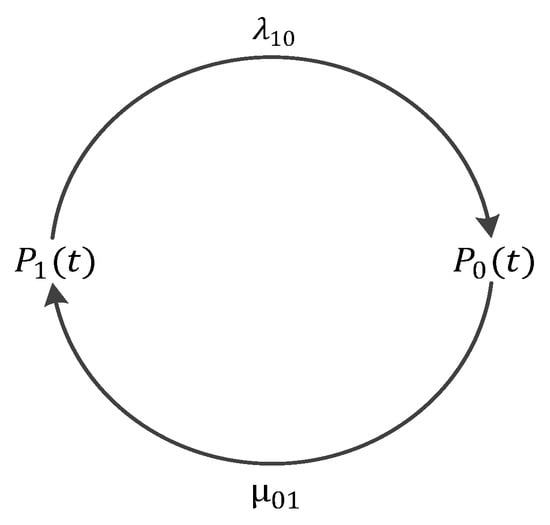
Figure 2.
System transmission state.
The probability (t) for each state (j) in the given time (t) is expressed by the following differential Equations as (1) and (2):
where is availability and . Moreover, the initial condition of the system is . The causal loop diagram of this process is shown in Figure 2.
As shown in Figure 3, there are two different causal loops, which are normal and fault operation on system availability, and each has negative and positive effects. The failure and normal operation of system availability have both negative and positive effects and that there are two types of causal loops. The loop between normal operation and readiness is positive, while the loop between failure and availability is negative. As the failure and repair functions increase, the failure and normal operation states increase, respectively [5]. The probability of the reliable operation of each underground communication system device is modeled for the first core system device with a single standby core system device and two parallel core system devices.
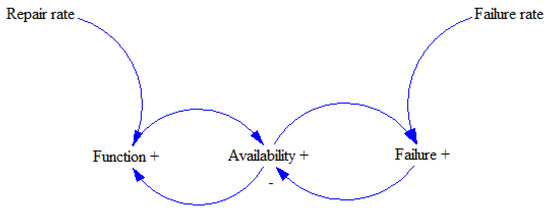
Figure 3.
Casual loop diagram of availability.
To determine the probability of system availability, this study was developed through the following methodology steps (Table 2 and Figure 4).

Table 2.
Research methodology.
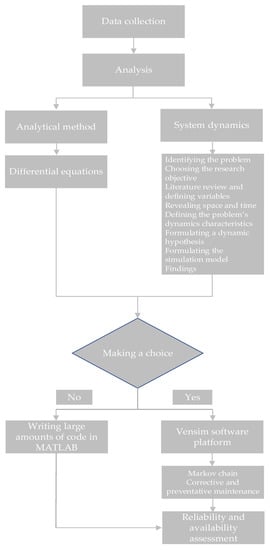
Figure 4.
Schematic diagram of research methodology.
Figure 5 shows that the connection line reliability of the three-shaft underground mine communication system shown in the previous Figure 1 (see Supplementary Materials) is modeled only for the site link of the first shaft.
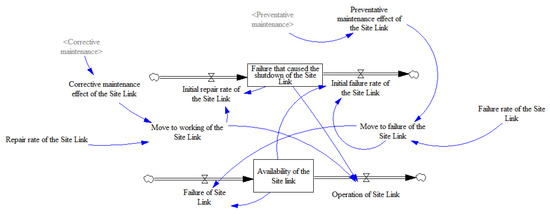
Figure 5.
Site link model.
Recommended algorithm:
Step 1: The values of variables (µ, λ) are taken as inputs. These were based on data from four years (2014–2018) of data on failures of the Oyu Tolgoi underground mining communication system. The total time (T) is taken as input, i.e., the time for which the system must be simulated.
Step 2: is taken as the initial value is equal to one.
Step 3: When , is taken as the value being 0.
Step 4: A conditional loop is formed with the condition t > T.
Step 5: In each execution of the loop, the time is increased by dt, i.e., t = t + dt. The loop continues until time (T) with each step taken at time difference dt.
Step 6: As assumed, initially has probability unity, and the system fails when it equals 0. When > 0 is satisfied, repetition is executed.
Step 7: At each repetition, all variables are calculated according to Formulas (3)–(6).
Step 8: All the required values are displayed, and graphs can be drawn using these values. Various experiments can be simulated.
The comparison results of the site link model shown in Figure 5 were shown in Figure 9 (see Supplementary Materials) in the Section 3.
The overall availability of a communication system without standby in a one-shaft underground mine is based on Markov analysis and system dynamics modeling, using data from the availability ratings provided by the manufacturer if the equipment was not damaged during this period. Availability model of the communication system without standby in a one- shaft underground mine which was shown in Figure 6 (see Supplementary Materials) and comparing results of the model were shown in Figure 11 (see Supplementary Materials) in the Section 3.
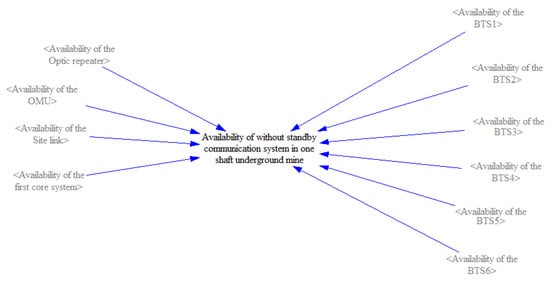
Figure 6.
Availability of a communication system without standby in a one-shaft underground mine.
2.1. Increasing the Probability of Communication System Availability or the Reliability of a Single Standby System
The standby system consists of two independently operating communication devices with parallel connections. It is believed that one device failure does not affect the other device. The system is defined by four states: (0, 0), (1, 0), and (0, 1) are operating states, and (1, 1) is a failure state. Figure 7 shows all possible states and transitions between them.
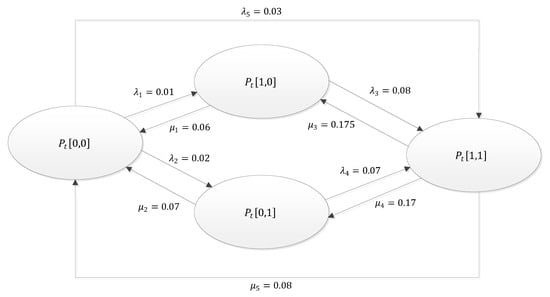
Figure 7.
Reliability model of a communication system with a single standby device.
Description of probability is shown in Figure 7:
is the probability that the system will run at time (t).
is the probability of the second device functioning and failure of the first device at time (t).
is the probability of the first device functioning and failure of the second device at time (t).
is the probability that the system will not function at time (t).
This system is modeled as the following system of four ordinary differential equations based on Markov analysis:
Initial condition of the system is:
To calculate the equation above, a distribution law to model the failure and repair parameters must be chosen. As the law of exponential distribution has been used often in research papers on device reliability [6], this study has been developed on exponential, Weibull, and Poisson distribution. The development results were almost identical and were considered only in the case of the Weibull distribution law. The density function of Weibull distribution is determined using the following formula:
2.2. Model for a Dual Standby Communication System
The system consists of three communication devices with parallel connections, which operate independently.
The failure of one device was not considered to affect other devices. The system is divided into eight simple states based on Markov analysis: (0, 0, 0), (1, 0, 0), (0, 1, 0), (0, 0, 1), (1, 1, 0), (1, 0, 1), and (0, 1, 1) being operational states, and (1, 1, 1) a failure state. All possible states between them also transition, with changes shown in Figure 8.
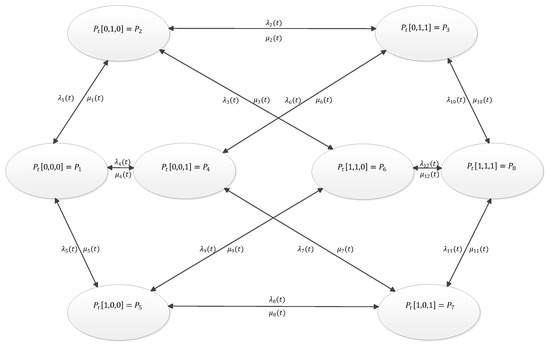
Figure 8.
Reliability model of a communication system with dual standby devices.
The “normal” mode of operating is when all devices are operating without interruption; one can fail, and when one fails, the second device can fail. Two devices cannot be in a failure state simultaneously; if the first one fails, and the second one fails, all three will fail. The repair parameters are the same as the failure parameters.
Description of probability is shown in Figure 8:
is the probability of system operation at time (t).
is the probability of the first device failing and operation of the second and third devices at time (t).
is the probability of the first and third devices being operational and the probability of the second device failing at time (t).
is the probability of the first and second devices being operational and the third device failing at time (t).
is the probability of the first and second devices failing and the third device being operational at time (t).
is the probability of the first and third devices failing and the second device being operational at time (t).
is the probability of the first device being operational and the second and third devices failing at time (t).
is the probability of the system not operating at time (t).
is the failure function when the operational status shifts from all three devices being in a normal state to the second device failing.
is the transition failure function when the operational status shifts from the first and third devices being in a normal state and the second device failing to the first device being in a normal state and the second and third devices failing.
is the transition failure function when the operational status shifts from the first and third devices being in a normal state and the second device failing to the third device being in a normal state and the first and the second devices failing.
is the transition failure function when the operational status shifts from the three devices being in a normal state to the first and second devices being in a normal state and the third device failing.
is the transition failure function when the operational status shifts from the three devices all being in a normal state to the second and third devices being in a normal state and the first device failing.
is the transition failure function when the operational status shifts from the first and second devices being in a normal state and the third device failing to the first device being in a normal state and the second and third devices failing.
is the transition failure function when the operational status shifts from the first and second devices being in a normal state and the third device failing to the second device being in a normal state and the first and third devices failing.
is the transition failure function when the operational status shifts from the second and the third devices being in a normal state and the first device failing to the second device being in a normal state and the first and third devices failing.
is the transition failure function when the operational status shifts from the second and third devices being in a normal state and the first device is failing to the third device being in a normal state and the first and second devices failing.
is the transition failure function when the operational status shifts from the first device being in a normal state and the second and third devices failing to all three devices failing.
is the transition failure function when the operational status shifts from the second device being in a normal state and the first and third devices failing to all three devices failing.
is the transition failure function when the operational status shifts from the third device being in a normal state and the first and second devices failing to all three devices failing.
The repair functions were defined in the same way as the matching failure functions.
The system is modeled with the following system of ordinary differential equations:
The initial condition of the system was defined as:
The availability function can be expressed as:
Reliability operation probability can be expressed as the formula:
We used the case of Weibull distribution in this paper:
3. Results and Discussion
The general structure of the three-shaft underground mine communication system shown in Figure 1 is illustrated for the Motorola Dimetra (TETRA) communication system, for the first one-shaft underground mine communication system, Oyutolgoi mine communication system failure data (see Supplementary Materials) was used and modeled using availability information (see Supplementary Materials) provided by the manufacturer of the Motorola Dimetra (TETRA) communication system to develop availability probabilities for two- and three-shaft underground mine communication systems. Figure 9 graphically shows the availability simulation results for one-, two-, and three-shaft underground mine communication systems, separately and together. According to the results of the probabilities of these communication systems availability (shown in Table 3) the availability probability of the three-shaft underground mine communication system shows the highest result of 85.18%, compared to the availability probability results of the one- and two-shaft underground mine communication system. In other words, the probability of communication system availability after an average of 10 years of operation in underground mines is 81.26% for the one-shaft communication system, 62.38% for the two-shaft underground mine communication system or single-standby communication system, and the three-shaft showed results of 85.18% for an underground mine communication system or dual-standby communication system. Moreover, the three-shaft communication system can work with 100% availability probability for the first three years of operation. While the two-shaft underground mine communication system can work with 100% availability probability for the first two years in single-shaft underground mine communication systems or for communication systems without standby, the results show that it is possible to operate with 100% availability probability in the first year.
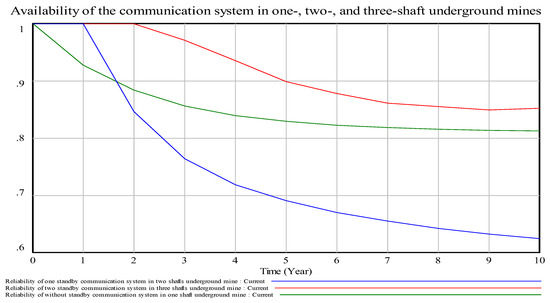
Figure 9.
Availability rate of the communication system with a one-, two-, and three-shafts mine.

Table 3.
Simulation results of one-, two-, and three-shaft underground mine communication system availability.
For a three-shaft underground mine, according to Motorola Dimetra (TETRA) system specifications, each shaft has one core system, six base stations, one site link, one optical repeater and one optical cable management device, (a total of 3 core systems, 18 base stations, 3 site links, 3 optical repeaters and 3 optical cable management devices) which were modeled and developed for each shaft and for in general (Figure 9) (see Supplementary Materials).
Figure 10 and Table 4 (see Supplementary Materials), on the other hand, shows the simulation results of combined corrective and preventative maintenance, results after corrective maintenance was doubled, and when preventative maintenance was increased by 50%. In the current situation, there is a single site link that has no recourse site link. According to the results shown in this graph, the current availability rate of the site link was 78.27%. When preventative maintenance was increased by 50%, the availability rate of the site link increased by 84.41% and by 6.14% compared to the status. After doubling corrective maintenance, the rate increased by 87.77% and by 9.5% compared to the status, and after combining preventative and corrective maintenance, availability increased by 91.5% and by 13.23% compared to the status. Simulations were developed for the existing and without standby communication system, after doubling corrective maintenance and a 50% increase in preventive maintenance, as well as combining both corrective and preventive maintenance.
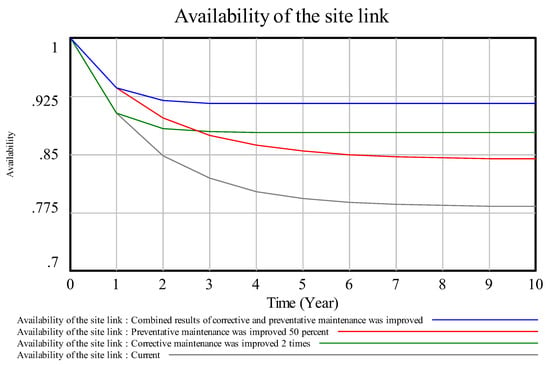
Figure 10.
Results of the compared simulation of the site link.

Table 4.
Simulation results of site link availability.
The simulation was performed by doubling the current and corrective maintenance to the without standby communication system in one shaft underground mine and by combining corrective and preventative maintenance after a 50% increase in preventative maintenance. In the communication system without standby in the one-shaft underground mine, the current availability rate was 73.95%, and after increasing preventative maintenance by 50%, the availability rate was 81.26%, and 9.8% compared to the status. After doubling corrective maintenance, it was 85.27% and 15.6% compared to the status, and after combined corrective and preventative maintenance, it was 89.75% and 21.3% compared to the status (Figure 11 and Table 5) (see Supplementary Materials).

Figure 11.
Simulation results of the without standby communication system in one shaft underground mine.

Table 5.
Simulation results of single-shaft underground mine communication system reliability without standby system (included preventive and corrective maintenance analysis).
To improve the reliability of the communication system, a standby system is necessary. In the last part of the study, the results of the development using system dynamics modeling show how the reliability of the single- and dual-standby system is improved.
According to the system dynamic model—which was developed during the study—and results of the simulations, the models fully achieved the originally set goals of improving the communication system’s reliability. The results of this research are compared to previous studies. Our research dealt with the standby system and is based on the example of underground mine communication systems. This study is innovative in the way it is modeled and developed for each device and the system as a whole [5]. In addition, it studied single standby parallel systems and dual standby three-parallel systems. Weibull, Poisson, and exponential distribution were uniquely developed to model the system dynamics of a communication system [6].
4. Implications and Limitations of the Study
The main contribution of our study is to develop a traditional differential equation system and system dynamic modeling method and suggested a methodology for calculating the reliability of the communication system using a combined method. The data about Oyu Tolgoi communication system failure was used in development this method. The most important result is that the interdependence model of the devices included in the communication system was established based on their conditional probabilities (Figure 11) on the example of the one-shaft underground mine communication system and it was possible to test the availability degree of each device and the entire system by simulating with the help of Oyu Tolgoi mine communication system failure and maintenance functions and availability information provided by Motorola Dimetra (TETRA) communication system manufacturer. The results in Figure 9 were results of comparing the availability degrees of the three-shaft underground mine communication system shown in Figure 1. But Figure 10 was the results for the model shown in Figure 5 and when there was not any condition and when doubling the preventive maintenance and after increasing the preventive maintenance by 50% and was considered a feature by simulating both corrective and preventive maintenance. Also, single- and dual standby system models are suggested in Figure 7 and Figure 8. As for the single- and dual standby system the models shown in Figure 7 and Figure 8 have been tested in MATLAB program only, given random data for the availability degree for the Exponential, Poisson, and Weibull distributions. In other words, the failure and maintenance functions of the Oyu Tolgoi mine communication system and the availability information provided by the Motorola Dimetra (TETRA) communication system manufacturer were not used in both models. Thus, the models shown in Figure 5 and Figure 6 and the results shown in Figure 9, Figure 10 and Figure 11 were varied from the models shown in Figure 7 and Figure 8 by processing using TETRA communication system devices and their failure and manufacturer’s availability data. The results for the Exponential, Poisson, and Weibull distributions of the models shown in Figure 7 and Figure 8 varied according to the time, due to the availability degree was unstable across the three distributions. In this regard, the results of the models shown in Figure 7 and Figure 8 were not included in this paper, and the problems faced during the study of this model were included detailly in this section. As for the methodology of the study, the system dynamic modeling methodology was not considered as the main research methodology, and we considered the system dynamic modeling methodology as a way of calculating the formulated calculation. In other words, we use a causal loop diagram, which is the basis of the system dynamic modeling methodology, formulated the basic model in the form of an ordinary differential equation without defining the feedback links, and performed its analysis using the Vensim program. This is another feature of this study. The work in [5] was based on the idea that one way to improve the reliability of any equipment in the research work is to increase the maintenance, using the failure data of Oyu Tolgoi underground mine communication system in 2014–2018, the probability of reliable operation was calculated for each device of the communication system in the mine. This is one of the distinguishing features of the work [5]—calculating the probability of reliable operation of the entire communication system by expanding it. The authors of [6] showed in a research paper that one way to improve the reliability of any equipment is to have a resource system available, and it is formulated as an ordinary differential equation for a system with single resource, by Weibull’s distribution law. By using it, the system with single- and two-resources considering the reliability of an underground mine communication system is formulated in ordinary differential form by Weibull distribution law and was calculated using the system dynamic modeling methodology in Vensim software, and the results were compared with each other and with the maintenance improvement method. This was an advantage of the study. Oyu Tolgoi communication system failure data were collected only between 2014 and 2018, and it was difficult to collect data after 2018, because the underground mine communication system was in the construction phase, and this process is still ongoing. In addition, since the monitoring system at that time was in the process of being updated from 2018, the failure data after 2018 were not recorded correctly until 2021, which were the main limitations that occurred in the time and data collection process of our study.
- Simulating and testing in MATLAB requires a lot of programming code, and it was relatively easy to simulate and test in Vensim. One of the main advantages of system dynamic modeling was the ease of conducting experiments with different parameter values.
- When the failure function (λ) and repair function (μ) values of three parallel communication systems (communication system in a one-, two-, and three-shaft mine) were modeled by the Weibull distribution law, the reliability was not converged to a fixed number, that is, it was not stabilized. Therefore, for the case of three parallel communication systems, the Weibull distribution was left.
- Moreover, for dual- and triple-parallel communication systems, we entered the failure function (λ) and correction function (μ) mixed, or exponent on the failure function (λ), Poisson on the correction function (μ), or failure function (λ) or Weibull on the correction function (μ), exponential distribution on the correction function (μ), etc. But this idea was not implemented because the reliability index was not stabilized.
- While calculating reliability model of a communication system with a single standby device (Figure 7) and reliability model of a communication system with dual standby devices (Figure 8), we tried using the dsolve command in MATLAB, but it took a long time to receive the results. Therefore, the dsolve command was replaced by the ode23 command to complete the calculation.
- When the values of failure function (λ) and repair function (μ) were assumed to be governed by Poisson distribution law, the factorial of t (t!) was included our formula, which made it difficult to calculate differential equations. Therefore, the factorial of t (t!) was replaced by Stirling formula.
- In the design of reliability model of a communication system with dual standby devices considering all options, some cases were left because differential equation systems were computationally and conceptually difficult. For example: it was left out that these three systems are working and all three stop at the same time, i.e., one device starts to stop, then the second device stops, and finally the third device stops, so all three parallel systems are modeled in such way that all of them stop.
5. Conclusions
As a result of this study, the impact of increasing corrective and preventative maintenance to improve the reliability of underground mine communication systems is made evident. In the case of the communication system without standby in the one-shaft underground mine studied, the current availability rate was 73.95%, and after increasing preventative maintenance by 50%, the availability rate was 81.26% and 9.8% compared to the status. After doubling corrective maintenance, it was 85.27% and 15.6%, compared to the status and after combined corrective and preventative maintenance, it was 89.75% and 21.3% compared to the status. The most significant result was a model of the interdependence of devices included in the communication system without standby in the one-shaft underground mine, built based on their conditional probabilities (Figure 11). The model makes it possible to simulate the availability rate of each device and the availability of the communication system without standby in the one-shaft underground mine using failure and maintenance functions. The new model is also suggested for developing the rate probability of the availability of underground mine communication system with one, two, and three shafts. According to the original objectives of our study, a methodology was developed that allows for simulation development of the communication system without standby in the one-shaft underground mine, which shows the impact of doubling the current and corrective maintenance without standby after increasing preventative maintenance by 50% and increasing corrective and preventative maintenance simultaneously. The results of our study show that using system dynamics modeling instead of traditional methods provides a simple simulation model that can be used to study the reliability and availability of any communication system. In this paper, real-time failure data of a system was used for simulation development. System failure data was not used to develop a model for single and dual standby systems. By being based on a real operating system, the models that were developed are suitable for practical use.
The artificial intelligence-based neural system dynamic research methodology can be further developed based on our model. Moreover, based on the source in [17] it seems that it is possible to develop a diagnostic model based on Vensim software, not only on MATLAB (LabVIEW). Regarding future work on communication systems with single- and dual standby system:
- Conduct experiment by replacing variable values (µ, λ) instead of real system values (system failure values);
- In the dual standby communication system, it is expected that no two devices will be in failure state at the same time, and if one is in failure, then the second will be in failure state, and then all three will be in failure state. Moreover, the maintenance parameters are considered to be exactly the same as the failure parameters.
- Conducting an experiment in the case of if two devices fail simultaneously, the third device does not fail, and vice versa; when the third device fails, the first and second devices do not fail.
- The reason why these conditions were not considered in this paper is because the system of differential equations was very large and complicated to calculate.
6. Patents
The part included in this paper that uses the system dynamic model, under the name of the work “Analysis of the reliability of underground mine radio communication system using system dynamic modeling” received copyright certificate No. 12,388 from the Mongolian Intellectual Property Authority on 25 January 2021.
Supplementary Materials
The following supporting information can be downloaded at: https://www.mdpi.com/article/10.3390/app13020821/s1.
Author Contributions
Conceptualization, B.B. and U.B.; methodology, B.B.; software, U.B.; validation, B.B., O.B. and U.B.; formal analysis, B.B.; investigation, B.B.; resources, B.B.; data curation, B.B.; writing—original draft preparation, B.B.; writing—review and editing, B.B.; visualization, B.B.; supervision, B.B.; project administration, U.B.; funding acquisition, B.B. All authors have read and agreed to the published version of the manuscript.
Funding
This research received no external funding.
Institutional Review Board Statement
Not applicable.
Informed Consent Statement
Not applicable.
Data Availability Statement
All data are contained within the article and the Supplementary materials.
Conflicts of Interest
The authors declare no conflict of interest.
Abbreviations
The following abbreviations are used in this manuscript:
| Dimetra | Digital Motorola Enhanced Trunked Radio |
| TETRA | Terrestrial Trunked Radio |
| MSD | Markov system dynamics |
| OMU | Optic management unit |
| BTS | Base transceiver station |
| RF | Radio frequency |
References
- Bazargur, B.; Bataa, O. A study of Mining Communication System Reliability Model. In Proceedings of the 13th International Forum on Strategic Technology (IFOST 2018), Harbin, China, 31 May–1 June 2018. [Google Scholar]
- Bazargur, B.; Bataa, O.; Budjav, U. Underground Mining Radio Communication System’s Risk and Reliability. Batzorig Bazargur J. Eng. Res. Appl. 2018, 8 Pt II, 36–39. [Google Scholar]
- Bazargur, B.; Bataa, O.; Khurelbaatar, Z.; Battseren, B. Experimental Measurements and Antenna Isolation for TETRA Communication System in Underground Mining and decline. In Proceedings of the ETTC-2018, Conference Proceeding, Europian Test and Telemetry Conference, Nuremberg, Germany, 26–28 June 2018. [Google Scholar]
- Bazargur, B.; Bataa, O.; Budjav, U.; Gantumur, G. Analysis of Radio Communication Networks in Underground Mining for Emergencies. In Proceedings of the 2019 21st International Conference on Advanced Communication Technology (ICACT), Pyeongchang, Republic of Korea, 17–20 February 2019. [Google Scholar]
- AKhorshidi, H.; Indra Gunawan, M.; Ibrahim, Y. Reliability Centered Maintenance Using System Dynamics Approach. In Proceedings of the IEEE International Conference on Industrial Technology (ICIT), Seville, Spain, 10–12 March 2021. [Google Scholar]
- Temraz, N.S. Availability and Reliability Analysis for System with Bivariate Weibull Lifetime Distribution. Int. J. Sci. Eng. Res. 2017, 8, 376–389. [Google Scholar]
- Parol, M.; Wasilewski, J.; Wojtowicz, T.; Arendarski, B.; Komarnicki, P. Reliability Analysis of MV Electric Distribution Networks Including Distributed Generation and ICT Infrastructure. Energies 2022, 15, 5311. [Google Scholar] [CrossRef]
- Wei, G. System Reliability Modeling and Analysis of Distributed Networks, Hindawi. Adv. Multimed. 2022, 2022, 9719427. [Google Scholar] [CrossRef]
- Antosz, K.; Machado, J.; Mazurkiewicz, D.; Antonelli, D.; Soares, F. Systems Engineering: Availability and Reliability. Appl. Sci. 2022, 12, 2504. [Google Scholar] [CrossRef]
- Odeyar, P.; Apel, D.B.; Hall, R.; Zon, B.; Skrzypkowski, K. A Review of Reliability and Fault Analysis Methods for Heavy Equipment and Their Components Used in Mining. Energies 2022, 15, 6263. [Google Scholar] [CrossRef]
- Morad, A.M.; Pourgol-Mohammad, M.; Sattarvand, J. Application of reliability-centered maintenance for productivity improvement of open pit mining equipment:Case study of Sungun Copper Mine. J. Cent. South Univ. 2014, 21, 2372–2382. [Google Scholar] [CrossRef]
- Chumai, R. System Dynamic Modeling of Plant Maintenance Strategy in Thailand; Asian University: Chon Buri, Thailand, 2009. [Google Scholar]
- Rully, M.; Hendrawana, A.; Aristioa, A.P.; Bulialib, J.L.; Yuniartoc, M.N. Testing Methods on System Dynamics: A Model of Reliability, Average Reliability, and Demand of Service. ScienceDirect. Procedia Comput. Sci. 2019, 161, 968–975. [Google Scholar]
- Rao, M.S.; Naikan, V.N.A. Reliability analysis of repairable systems using system dynamics modeling and simulation. J. Ind. Eng. Int. 2014, 10, 69. [Google Scholar] [CrossRef]
- Tamaloussi, N.; Bouzaouit, A. Study of Reliability in a Repairable System by Markov Chains. Acta Univ. Sapientiae Electr. Mech. Eng. 2020, 12, 66–76. [Google Scholar] [CrossRef]
- Rao, M.S.; Naikan, V.A. A hybrid Markov system dynamics approach for availability analysis of degraded systems. In Proceedings of the 2011 International Conference on Industrial Engineering and Operations Management, Kuala Lumpur, Malaysia, 22–24 January 2011. [Google Scholar]
- Liu, Y. Artificial Intelligence–Based Neural Network for the Diagnosis of Diabetes: Model Development. JMIR Med. Inform. 2020, 8, e18682. [Google Scholar] [CrossRef] [PubMed]
Disclaimer/Publisher’s Note: The statements, opinions and data contained in all publications are solely those of the individual author(s) and contributor(s) and not of MDPI and/or the editor(s). MDPI and/or the editor(s) disclaim responsibility for any injury to people or property resulting from any ideas, methods, instructions or products referred to in the content. |
© 2023 by the authors. Licensee MDPI, Basel, Switzerland. This article is an open access article distributed under the terms and conditions of the Creative Commons Attribution (CC BY) license (https://creativecommons.org/licenses/by/4.0/).